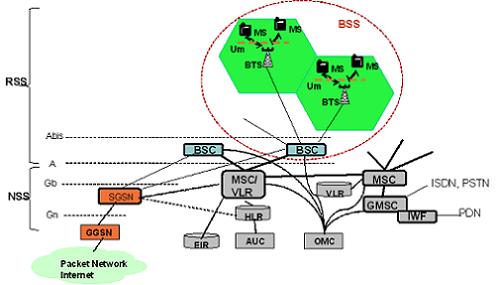4G5GWorld has a new home now. Visit TelecomGrid for new stories and blogs!
General packet radio service (GPRS)
General packet radio service (GPRS) is a packet oriented mobile data service available to users of the 2G cellular communication systems global system for mobile communications (GSM), as well as in the 3G systems. GPRS enhances the existing GSM infrastructure by adding a packet solution that provides a simplified access to packet networks such as the Internet. With Same Bandwidth and Same radio interface as GSM.
2G cellular systems combined with GPRS are often described as 2.5G, that is, a technology between the second (2G) and third (3G) generations of mobile telephony. It was originally standardized by European Telecommunications Standards Institute (ETSI), but now by the 3rd Generation Partnership Project (3GPP).
This figure shows the evolved GSM/GPRS architecture. GPRS Coexist with GSM and uses same radio sells.
GPRS defines modifications to existing GSM network at radio subsystem as well as core network side to provide support to packet access.
Radio Access Evolution—GPRS networks uses MODIFIED versions of the GSM Base Station Subsystem (BSS) with software/hardware changes to the BTS and BSC.
Core Network Evolution—GPRS defines a new Packet Switched - Core Network (PS-CN) to provide access to external packet networks for GPRS Mobile Stations or devices.
GSM Vs. GPRS
In a circuit switched call, a user is dedicated resources (i.e., frequency and timeslot combination) during the call setup, and has exclusive use of those resources for the duration of the call.
This design is suitable for voice calls as the traffic is generally continuous and symmetrical (an equal amount of data is flowing in the uplink and the downlink). However this design is an inefficient means of transferring packet data because it is generally bursty and asymmetrical.
GPRS extends GSM by allowing multiple users to share a single resource. This allows the precious air interface resources to be used more efficiently. GPRS allows users to take turns sending and receiving data on a given timeslot. This may decrease the data rates for the user, but will allow the system to support more concurrent users.
